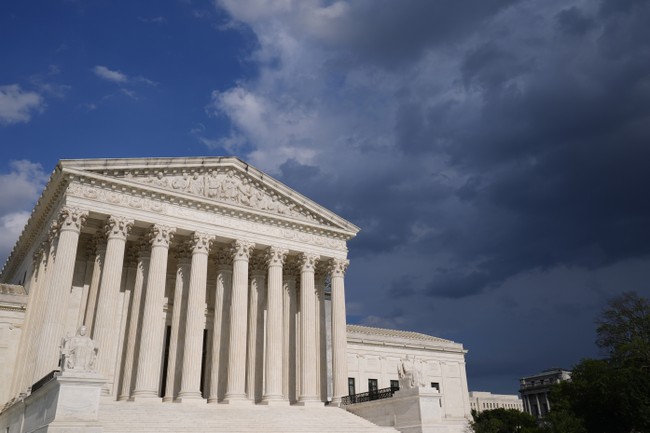
Is this a win? Procedurally, it’s more of a pause, and may not even be much of a pause, as we’ll see. It may, however, send an important signal to lower courts, and to judges inclined to toss sand in the gears of the executive branch. Maybe.
Earlier this afternoon, the Supreme Court intervened to stay an order by a San Francisco judge that had ordered the Trump administration to reinstate 16,000 probationary employees. The ruling galvanized Donald Trump and supporters, already outraged by district courts issuing nationwide injunctions, and demanding action from the top court to put a stop to jurisdictional overreach.
That’s not the basis for this decision, however, even if it was part of the ruling yesterday on the Alien Enemies Act challenge. This time, the court focused on standing instead, in a ruling that may have little practical effect, as the New York Times notes, and doesn’t even apply to all of the potential plaintiffs in the action:
The Supreme Court on Tuesday blocked a ruling from a federal judge in California that had ordered the Trump administration to rehire thousands of fired federal workers who had been on probationary status.
The court’s brief order said the nonprofit groups that had sued to challenge the dismissals had not suffered the sort of injury that gave them standing to sue.
The practical consequences of the ruling may be limited, as another trial judge’s ruling requiring the reinstatement of many of the same workers remains in place.
That ruling came in Maryland a month ago, and NBC News included the link in their report on today’s action:
U.S. District Judge James Bredar in Maryland issued a temporary restraining order against dozens of agencies, departments and their leaderships across the federal government that had terminated workers as part of reduction-in-workforce efforts.
“In this case, the government conducted massive layoffs, but it gave no advance notice. It claims it wasn’t required to because, it says, it dismissed each one of these thousands of probationary employees for ‘performance’ or other individualized reasons,” Bredar wrote in his ruling.
“On the record before the Court, this isn’t true. There were no individualized assessments of employees. They were all just fired. Collectively,” he added.
Presumably, the Trump administration has appealed this order to the Fourth Circuit and asked either that court or the Supreme Court for a stay. The appellate court may not have had it for long, however, since Judge Bredar issued a final ruling only last week. Perhaps the Fourth Circuit hasn’t yet responded to such a request, if a request has been made at all. If the Fourth Circuit hasn’t stayed it yet, the Supreme Court may have another request coming soon from the Trump administration.
Until then, this leaves the employees in limbo. Those covered in the Maryland case have to be reinstated by Bredar’s order, even if the order by Judge William Alsup has been stayed, and there may be considerable overlap. (Bredar limited his order to federal employees in the 19 states that brought the lawsuit.) But what they do while being reinstated is somewhat strange to consider. Their jobs had been eliminated, and the administration will certainly keep trying to eliminate them going forward. The administration won’t assign these employees any tasks that will provide evidence of either their necessity or fitness for the job, at least not if the administration can help it. These employees may just have to check in as a kind of paid, in-house leave.
The Supreme Court split 7-2 on today’s order, which was even more technical than the ruling on the Alien Enemies Act (AEA). The order questions the standing of plaintiffs rather than the jurisdiction of the particular court:
The application for stay presented to Justice Kagan and by her referred to the Court is granted. The March 13, 2025 preliminary injunction entered by the United States District Court for the Northern District of California, case No. 3:25-cv1780, is stayed pending the disposition of the appeal in the United States Court of Appeals for the Ninth Circuit and disposition of a petition for a writ of certiorari, if such a writ is timely sought. Should certiorari be denied, this stay shall terminate automatically. In the event certiorari is granted, the stay shall terminate upon the sending down of the judgment of this Court.
The District Court’s injunction was based solely on the allegations of the nine non-profit-organization plaintiffs in this case. But under established law, those allegations are presently insufficient to support the organizations’ standing. See, e.g., Clapper v. Amnesty Int’l USA, 568 U. S. 398 (2013). This order does not address the claims of the other plaintiffs, which did not form the basis of the District Court’s preliminary injunction.
Frankly, this looks like a punt. Some federal employees may get terminated at this point, but not all of them even in the Alsup order. The court doesn’t seem moved to address jurisdictional issues like they did in yesterday’s decision on the AEA, nor to address the point about executive authority over employment. Perhaps if they address Bredar’s more extensive ruling on appeal, they may choose to address those points, but at least so far, the top court appears to be avoiding those issues for as long as possible. Today’s order may not even pause much at all until then.
Perhaps this is a win in the sense that it wasn’t a total loss. And at the very least, it will remind district courts that the top court is paying closer attention than usual to these issues. But if the court is this reluctant to address executive authority and jurisdictional reach in an appeal where the Trump administration raised both, it doesn’t look promising for clear resolutions on those points later.
The latest episode of The Ed Morrissey Show podcast is now up! Today’s show features:
- What did I miss on my vacation? Not much, Andrew Malcolm informs me, except more of the same outrage as before!
- Andrew takes a critical look at the media industry and its credibility collapse. We discuss how their cover-up of Biden’s cognitive decline accelerated public distrust in their product.
- We also discuss the new literary genre known as Now It Can Be Told. Too soon, or too damned late?
The Ed Morrissey Show is now a fully downloadable and streamable show at Spotify, Apple Podcasts, the TEMS Podcast YouTube channel, and on Rumble and our own in-house portal at the #TEMS page!












